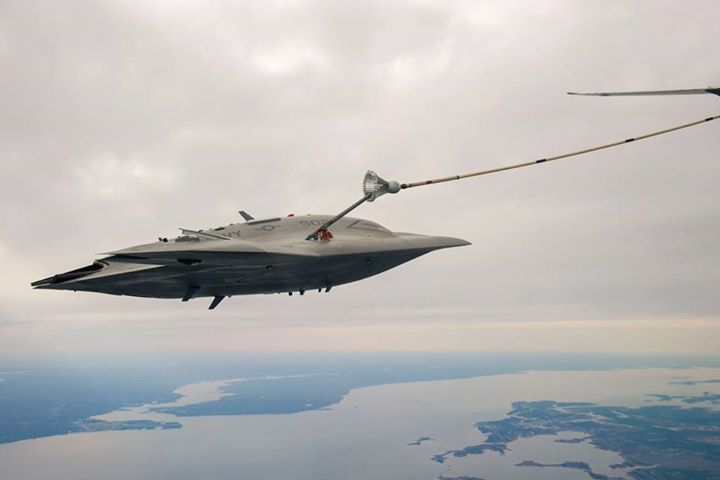X-47B Drone Set For Refueling Test Tomorrow
Posted on

The X-47B drone plugs into an aerial refueling tanker for the first time.
UPDATED Thursday with test results
NATIONAL HARBOR, MD: “Tomorrow, actually, the weather looks good,” said Capt. Beau Duarte, the Navy’s head of carrier-launched drone programs — at least, he added cautiously, as of “right now.”
If the weather holds, the Navy’s experimental X-47B drone will refuel in mid-air — the first time an unmanned aircraft has ever done so. On previous tests, the X-47B has maneuvered to within 30 feet of a flying tanker, holding position just behind the trailing fuel hose called a drogue. Tomorrow, using a new optical sensor rather than the high-precision GPS that has guided it on previous flights and carrier landings, the X-47B will close the gap and insert its refueling probe into the drogue.
[Update Thursday: Wednesday evening, the X-47B successfully connected to the tanker. The actual transfer of fuel still hasn’t happened, but that’s coming in subsequent days.]
Mid-air refueling is a nerve-wracking task for human pilots, but it’s essential to America’s global air superiority. Flying tankers let short-ranged fighters like the Navy’s F-18 launch from carriers at sea to strike targets as far inland as Afghanistan. For an unmanned aircraft, “tanking” holds even more potential. Even with all the fuel in the world, a manned aircraft is ultimately limited by the endurance of its human crew. An unmanned plane can just keep going, tanking over and over without tiring, until it runs out of ammunition or critical equipment breaks.
The superhuman endurance of drones — their robotic relentlessness — is why the Navy already envisions the X-47B’s successors, the as-yet-unbuilt UCLASS drones, as conducting 24-7 patrols around the aircraft carrier. UCLASS stands for “Unmanned Carrier-Launched Surveillance and Strike.” But there’s a bitter debate over whether UCLASS should emphasize the first S, surveillance, or the second, Strike, because an aircraft optimized for long, patient patrols, dropping an occasional bomb, is a very different design from one optimized for deep raids into defended airspace.
UCLASS can’t do both missions equally well. The Navy wrote up official requirements emphasizing the scouting mission, with at least 14 hours of flight time between refuelings (either on deck or in the air). The Office of the Secretary of Defense got skeptical and convened a high-level Strategic Portfolio Review (SPR, improbably pronounced “spear”), which has spent months debating the problem behind closed doors.
Duarte told reporters today at the Navy League’s annual Sea-Air-Space conference that he expects the review to finish “sometime this summertime.” In the meantime, while OSD wrestles with the UCLASS requirements, Duarte will keep working on the other components of the system: the Common Control Station that goes aboard the carrier and the communications network to link carrier to aircraft. Said Duarte, “this year, FY ’15, we’re already modifying two ships, CVN-70 Carl Vinson [and] CVN-77 George Bush,” to operate the UCLASS.
Once the Pentagon’s strategic review decides what the UCLASS aircraft needs to do, Duarte said, “we’ll see if any adjustments are required” in the existing Navy proposal, and issue the long-awaited Request For Proposals. “Industry is waiting with baited breath,” he said. Current budget plans call for a contract award in 2017 and the first operational UCLASS aircraft by 2023.
By then, the X-47B will probably be in a museum. It was always conceived as a demonstration program, Duarte said, and “it’s coming to a successful close — knock on wood — with the completion of the AAR [air-to-air refueling] flights over the next week or two.” In fact, Duarte has timed things so the program will expend the last of its budgeted dollars shortly after the tanker test flights are completed.
“We will have met all of the program’s mission objectives and will [take] those lessons learned, fold them into the UCLASS performance specification,” Duarte said. But UCLASS itself will be sufficiently different from X-47B — with a new control system, new landing system, and so on — that further tests using the current aircraft wouldn’t shed much light on developing the future plane. Before the fiscal year ends on October 1st, he said, the Navy will dispose of both X-47B drones, either to museums or the boneyard at Davis-Monthan Air Force Base. The aircraft will go from making history to being history.
Subscribe to our newsletter
Promotions, new products and sales. Directly to your inbox.
